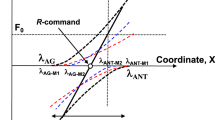Abstract
Movements of the dominant and nondominant hand have been claimed to differ with respect to how they take intersegmental dynamics into account. Consistent with this claim, movements of the dominant hand are hypothesized to better exploit the intrinsic limb dynamics, whereas movements of the nondominant hand are controlled to make the intrinsic dynamics ineffective as far as this is possible. For rapid finger oscillations this hypothesis implies a higher level of co-contractions in the nondominant than in the dominant hand. Replicating previous findings on finger tapping, finger oscillations of the dominant hand were faster and less variable than those of the nondominant hand. More importantly, the variance of the relative difference between myoelectric signals of antagonistic muscles and thus the power of reciprocal myoelectric activity was smaller in the nondominant hand, indicating a relatively higher level of co-contractions than in the dominant hand. In addition, a spectral decomposition of the total power of the relative-difference signal revealed stronger relative power in the frequency band of the finger oscillations in the dominant than in the nondominant hand. These findings are consistent with the hypothesis that for the dominant hand more accurate feedforward control is possible based on a more accurate internal model of limb dynamics.



Similar content being viewed by others
References
Ackerman PL, Cianciolo AT (2000) Cognitive, perceptual-speed, and psychomotor determinants of individual differences during skill acquisition. J Exp Psychol Appl 6:259–290
Annett M (2002) Handedness and brain asymmetry. The right shift theory. Psychology Press, Hove
Annett J, Annett M, Hudson PTW, Turner A (1979) The control of movement in the preferred and non-preferred hands. Q J Exp Psychol 31:641–652
Bagesteiro LB, Sainburg RL (2002) Handedness: dominant arm advantages in control of limb dynamics. J Neurophysiol 88:2408–2421
Bagesteiro LB, Sainburg RL (2003) Nondominant arm advantages in load compensation during rapid elbow joint movements. J Neurophysiol 90:1503–1513
Baker EL, Letz R, Fidler A (1985) A computer-administered neurobehavioral evaluation system for occupational and environmental epidemiology. J Occup Med 27:206–212
Balera F, Borroni P, Cavallari P (2000) Neural compensation for mechanical differences between hand and foot during coupled oscillations of the two segments. Exp Brain Res 133:165–177
Binsted G, Cullen J, Elliott D (1998) Manual asymmetries in goal-directed movement: examination of the motor output hypothesis. Brain Cognit 38:102–110
Bishop DVM (1989) Does hand proficiency determine hand preference? Br J Psychol 80:191–199
Calvin WH (1983) A stone’s throw and its launch window: timing precision and its implications for language and hominid brains. J Theor Biol 104:121–135
Carlier M, Dumont AM, Beau J, Michel F (1993) Hand performance of French children on a finger-tapping test in relation to handedness, sex, and age. Percept Mot Skills 76:931–940
Carson RG (1989) Manual asymmetries: feedback processing, output variability, and spatial complexity—resolving some inconsistencies. J Mot Behav 21:38–47
Carson RG (1993) Manual asymmetries: old problems and new directions. Hum Mov Sci 12:479–506
Carson RG, Goodman D, Chua R, Elliott D (1993) Asymmetries in the regulation of visually guided aiming. J Mot Behav 25:21–32
Darling WG, Cooke JD, Brown SH (1989) Control of simple arm movements in elderly human. Neurobiol Aging 10:149–157
Elliott D, Weeks DJ, Jones T (1986) Lateral asymmetries in finger-tapping by adolescents and young adults with Down syndrome. Am J Ment Defic 90:472–475
Fleishman A (1957) A comparative study of aptitude patterns in unskilled and skilled psychomotor performance. J Appl Psychol 41:263–272
Fleishman A (1960) Abilities at different stages of practice in rotary pursuit performance. J Exp Psychol 60:162–171
Fleishman EA, Hempel WE (1954) Changes in factor structure of a complex psychomotor test as a function of practice. Psychometrika 19:239–252
Fleishman EA, Hempel WE (1955) The relation between abilities and improvement with practice in a visual discrimination reaction task. J Exp Psychol 49:301–312
Flowers K (1975) Handedness and controlled movement. Br J Psychol 66:39–52
Gerdle B, Karlsson S, Day S, Djupsjöbacka M (1999) Acquisition, processing and analysis of the surface electromyogram. In: Windhorst U, Johansson H (eds) Modern techniques in neuroscience research. Springer, Berlin Heidelberg New York, pp 705–755
Hammond G (2002) Correlates of human handedness in primary motor cortex: a review and hypothesis. Neurosci Biobehav Rev 26:285–292
Hammond G, Bolton Y, Plant Y, Manning J (1988) Hand asymmetries in interresponse intervals during rapid repetitive finger tapping. J Mot Behav 20:67–71
Hatsopoulos NG. (1996) Coupling the neural and physical dynamics in rhythmic movements. Neural Comput 8:567–581
Heuer H (1987) Does a hand preference indicate a hemispheric specialization? Behav Brain Sci 10:277–278
Heuer H (2002) The effects of weak perturbations on rapid finger oscillations. Hum Mov Sci 21:119–130
Heuer H (2006) Temporal and spatial characteristics of rapid finger oscillations. Motor Control 10:212–231
Heuer H, Schulna R (2002) Phasing of muscle activity during rapid finger oscillations. J Mot Behav 34:277–289
Heuer H, Schulna R, Luttmann A (2002) The effects of muscle fatigue on rapid finger oscillations. Exp Brain Res 147:124–134
Hogan N (1984) Adaptive control of mechanical impedance by coactivation of antagonist muscles. IEEE Trans Autom Control 29:681–690
Jäncke L, Peters M, Schlaug G, Posse S, Steinmetz H, Müller-Gärtner H-W (1998) Differential magnetic resonance signal change in human sensorimotor cortex to finger movements of different rate of the dominant and subdominant hand. Cogn Brain Res 6:279–284
Jäncke L, Specht K, Mirzazade S, Peters M (1999) The effect of finger-movement speed on the dominant and the subdominant hand on cerebellar activation: a functional magnetic resonance imaging study. Neuroimage 9:497–507
Jäncke L, Steinmetz H, Benilow S, Ziemann U (2004) Slowing fastest finger movements of the dominant hand with low-frequency rTMS of the hand area of the primary motor cortex. Exp Brain Res 155:196–203
Kawato M (1999) Internal models for motor control and trajectory planning. Curr Opin Neurobiol 9:718–727
Kay BA, Kelso JAS, Saltzman E, Schöner G (1987) Space-time behavior of single and bimanual rhythmical movements: data and limit cycle model. J Exp Psychol Hum Percept Perform 13:178–192
McManus IC, Kemp RI, Grant J (1986) Differences between fingers and hands in tapping ability: ociation between speed and regularity. Cortex 22:461–473
Melsbach G, Wohlschläger A, Spiess M, Güntürkün O (1996) Morphological asymmetries of motoneurons innervating upper extremities: clues to the anatomical foundations of handedness? Int J Neurosci 86:217–224
Metz AM (1970) Änderungen der myoelektrischen Aktivität während eines sensomotorischen Lernprozesses. Zeitschrift für Psychologie 178:51–88
Milner TE, Cloutier C (1998) Damping of the wrist joint during voluntary movement. Exp Brain Res 122:309–317
Oldfield RC (1971) The assessment and analysis of handedness: the Edinburgh Inventory. Neuropsychologia 9:97–113
Peters M (1980) Why the preferred hand taps more quickly than the non-preferred hand: three experiments on handedness. Can J Psychol 34:62–71
Peters M, Durding B (1979) Left-handers and right-handers compared on a motor task. J Mot Behav 11:103–111
Provins KA (1956) “Handedness” and skill. Q J Exp Psychol 8:79–95
Provins KA (1958) The effect of training and handedness on the performance of two simple motor tasks. Q J Exp Psychol 10:29–39
Rack PMH, Westbury DR (1969) The effects of length and stimulus rate on tension in the isometric cat soleus muscle. J Physiol 204:443–460
Rosenbaum DA, Slotta JD, Vaughan J, Plamondon R (1991) Optimal movement selection. Psychol Sci 2:86–91
Roy EA, Kalbfleisch L, Elliott D (1994) Kinematic analyses of manual asymmetries in visual aiming movements. Brain Cogn 24:289–295
Sainburg RL (2002) Evidence for a dynamic-dominance hypothesis of handedness. Exp Brain Res 142:241–258
Sainburg RL, Kalakanis D (2000) Differences in control of limb dynamics during dominant and nondominant arm reaching. J Neurophysiol 83:2661–2675
Schmidt SL, Oliveira RM, Krahe TE, Filgueiras CC (2000) The effects of hand preference and gender on finger tapping performance asymmetry by the use of an infra-red light measurement device. Neuropsychologia 38:529–534
Seidler-Dobrin RD, Stelmach GE (1998) Persistence in visual feedback control by the elderly. Exp Brain Res 119:467–474
Serrien DJ, Ivry RB, Swinnen SP (2006) Dynamics of hemispheric specialization and integration in the context of motor control. Nat Rev Neurosci 7:160–167
Shimoyama I, Ninchoji T, Uemura K (1990) The finger-tapping test. A quantitative analysis. Arch Neurol 47:681–684
Sturm W, Büssing A (1985) Ergänzende Normierungsdaten und Retest-Reliabilitätskoeffizienten zur Motorischen Leistungsserie (MLS) nach Schoppe. Diagnostica 3:234–245
Tinker MA, Goodenough FL (1930) A comparative study of finger tapping in children and adults. Child Dev 1:152–159
Todor JI, Kyprie PM (1980) Hand differences in the rate and variability of rapid tapping. J Mot Behav 12:57–62
Viviani P, Soechting JF, Terzuolo CA (1976) Influence of mechanical properties on the relation between EMG activity and torque. J Physiol (Paris) 72:45–58
Volkmann J, Schnitzler A, Witte OW, Freund H (1998) Handedness and asymmetry of hand representation in human motor cortex. J Neurophysiol 79:2149–2154
Wachholder K (1933) Selbstgewähltes Bewegungstempo und seine Beziehung zum “Eigenrhythmus” und zur Ökonomie der Bewegung. Arbeitsphysiologie 7:423–429
Wenderoth N, Bock O (1999) Load dependence of simulated central tremor. Biol Cybern 80:285–290
Zipp P (1982) Recommendations for the standardization of lead positions in surface electromyography. Eur J Appl Physiol 50:41–54
Acknowledgment
The research reported in this paper was supported by grant He 1187/12-1 of the Deutsche Forschungsgemeinschaft. I thank Raphael Schulna, Stefan Hohmann, and Alexander Waschkau for their support in running the experiment, and Alwin Luttmann for stimulating discussions of ways to analyse EMG signals.
Author information
Authors and Affiliations
Corresponding author
Rights and permissions
About this article
Cite this article
Heuer, H. Control of the dominant and nondominant hand: exploitation and taming of nonmuscular forces. Exp Brain Res 178, 363–373 (2007). https://doi.org/10.1007/s00221-006-0747-5
Received:
Accepted:
Published:
Issue Date:
DOI: https://doi.org/10.1007/s00221-006-0747-5




